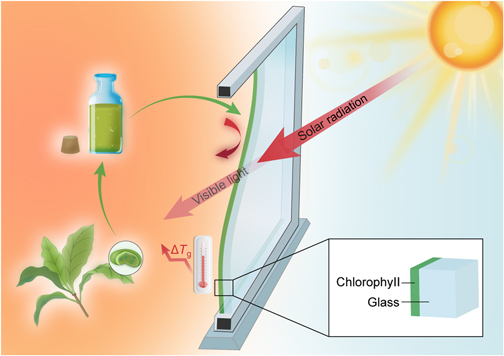Crossref Citations
This article has been cited by the following publications. This list is generated based on data provided by
Crossref.
Zhao, Yuan
Lin, Jou
Kundrat, David M.
Bonmarin, Mathias
Krupczak, John
Thomas, Som V.
Lyu, Mengyao
and
Shi, Donglu
2020.
Photonically-Activated Molecular Excitations for Thermal Energy Conversion in Porphyrinic Compounds.
The Journal of Physical Chemistry C,
Vol. 124,
Issue. 2,
p.
1575.
Lyu, Mengyao
Lin, Jou
Krupczak, John
and
Shi, Donglu
2020.
Light angle dependence of photothermal properties in oxide and porphyrin thin films for energy-efficient window applications.
MRS Communications,
Vol. 10,
Issue. 3,
p.
439.
Lin, Jou
Zhao, Yuan
and
Shi, Donglu
2020.
Optical thermal insulation via the photothermal effects of Fe3O4 and Fe3O4@Cu2-xS thin films for energy-efficient single-pane windows.
MRS Communications,
Vol. 10,
Issue. 1,
p.
155.
Guo, Min
Gao, Linjiao
Wei, Yi
Ma, Ying
Jianyong, Yu
and
Ding, Bin
2021.
Solar transparent radiators based on in-plane worm-like assemblies of metal nanoparticles.
Solar Energy Materials and Solar Cells,
Vol. 219,
Issue. ,
p.
110796.
Khaled, Khaled
and
Berardi, Umberto
2021.
Current and future coating technologies for architectural glazing applications.
Energy and Buildings,
Vol. 244,
Issue. ,
p.
111022.
Lyu, Mengyao
Lin, Jou
and
Shi, Donglu
2021.
Solar Desalination via Multilayers of Transparent Photothermal Fe3O4@Cu2–xS Thin Films.
Energy Technology,
Vol. 9,
Issue. 11,
Lin, Jou
and
Shi, Donglu
2021.
Photothermal and photovoltaic properties of transparent thin films of porphyrin compounds for energy applications.
Applied Physics Reviews,
Vol. 8,
Issue. 1,
Lin, Jou
Krupczak, John
and
Shi, Donglu
2022.
Solar harvesting and energy generating building skins with photothermal–photovoltaic dual-modality based on porphyrin thin films.
MRS Communications,
Vol. 12,
Issue. 6,
p.
1225.
Liu, Sai
Li, Yang
Wang, Ying
Yu, Kin Man
Huang, Baoling
and
Tso, Chi Yan
2022.
Near‐Infrared‐Activated Thermochromic Perovskite Smart Windows.
Advanced Science,
Vol. 9,
Issue. 14,
Lin, Jou
Wang, Yuxin
Lyu, Mengyao
Deng, Zicheng
and
Shi, Donglu
2022.
Transparent porphyrin-based hybrid films for spectral selective solar harvesting and energy generation.
Solar Energy Materials and Solar Cells,
Vol. 243,
Issue. ,
p.
111788.
Lyu, Mengyao
Lin, Jou
Wang, Yuxin
Krupczak, John
and
Shi, Donglu
2023.
Synergistic photothermal-thermoelectric-photovoltaic energy generation via a transparent spectral modulating solar module.
Solar Energy,
Vol. 258,
Issue. ,
p.
220.
Lin, Jou
Lyu, Mengyao
and
Shi, Donglu
2023.
3D Solar Harvesting and Energy Generation via Multilayers of Transparent Porphyrin and Iron Oxide Thin Films.
Energies,
Vol. 16,
Issue. 7,
p.
3173.
Katepalli, Anudeep
Wang, Yuxin
and
Shi, Donglu
2023.
Solar harvesting through multiple semi-transparent cadmium telluride solar panels for collective energy generation.
Solar Energy,
Vol. 264,
Issue. ,
p.
112047.
Lyu, Mengyao
Lin, Jou
Wang, Yuxin
Aulakh, Ovais
Ceja, Nathan
Ramesh, Mary Sheryl
Salazar, Elisabeth
Krupczak, John
and
Shi, Donglu
2023.
Enhanced Silicon Photovoltaic Efficiency by Solar Light Spectral Modulation via Photonically Tuned Porphyrin–Iron Oxide Hybrid Thin Films.
Energy Technology,
Vol. 11,
Issue. 7,
Lin, Jou
Lyu, Mengyao
Wang, Yuxin
Webster, Brent
and
Shi, Donglu
2023.
Advanced Materials in Smart Building Skins for Sustainability.
p.
1.
Shum, Caitlyn
and
Zhong, Lexuan
2023.
A review of smart solar shading systems and their applications: Opportunities in cold climate zones.
Journal of Building Engineering,
Vol. 64,
Issue. ,
p.
105583.
Berardi, Umberto
and
Khaled, Khaled
2024.
Encyclopedia of Sustainable Technologies.
p.
361.
Correia, Sandra F. H.
P. Falcão, Bruno
Figueiredo, Gonçalo
Vaz, Bárbara M. C.
Contieri, Letícia S.
de Souza Mesquita, Leonardo M.
Almeida, Juliana
Fradinho, Joana C.
Pinto, Diana C. G. A.
Fu, Lianshe
André, Paulo S.
Ventura, Sónia P. M.
Ferreira, Rute A. S.
and
Sencadas, Vitor
2025.
Transparent nature-based luminescent solar concentrator with NIR emission and integrated thermal sensing.
Journal of Materials Chemistry A,
Vol. 13,
Issue. 16,
p.
11886.
Shi, Donglu
2025.
Three-Dimensional Solar Harvesting with Transparent Spectral Selective Photovoltaics in Agrivoltaics.
Energies,
Vol. 18,
Issue. 7,
p.
1788.
Wu, Tianbao
Fan, Xueping
Wang, Chao
and
Jia, Guozhi
2025.
The bimetallic synergistic enhancement of photothermal properties in tannic acid-grafted MoS2.
Optical Materials,
Vol. 168,
Issue. ,
p.
117454.


